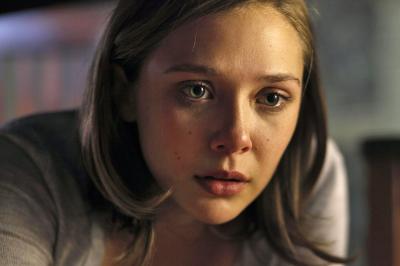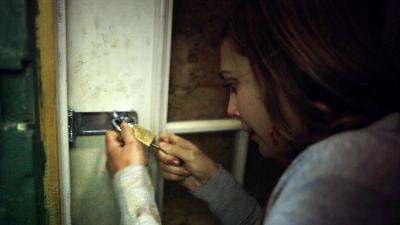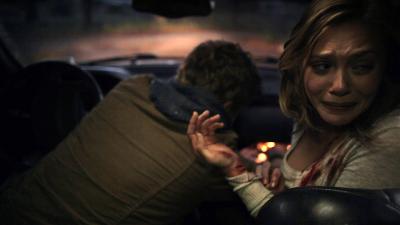By: debbie lynn elias

On looking at the movie posters and trailers for SILENT HOUSE, one gets the impression that this is a film melding thriller/horror genres – dark spooky house, a waifish young blonde, dim single light, images down the hall, sudden noises and occurrences, screaming, silent screaming, anguished tortured faces. And then publicity a la Blair Witch, teasing the audience that the film is shot in real time, 88 minutes worth. All of the elements are there leading one to believe that SILENT HOUSE is one scarey suspense ride. Unfortunately, it’s not. While the film technically excels from purely a cinematographic lighting and lensing aspect, and some excellent production design, in terms of story and the ultimate plot payoff (which would be a spoiler to disclose, and I won’t) the film never achieves even the minimal fright factor of the true events or original film, La Casa Muda, on which SILENT HOUSE is based.
Sarah has begrudgingly returned to her family’s summer home in New England to help her dad and Uncle Peter ready it for sale. For whatever reason, she is not too fond of the childhood summers she spent here but is reticent about it being sold. Empty for years, the once statuesque lakeside house has fallen into disrepair. Once gleaming windows from which one could look out into the world and the serenity and beauty of the crystalline lake, are now all boarded up with thick plywood, having been broken, allegedly by squatters. Inside, wallpaper is peeling, plumbing is leaking, sprawling black mold within the walls has infiltrated beyond them in some rooms baring its ugly odorous self on once gayly flowered wallpaper. Leaves and litter are strewn about the house. Electrical wiring is frayed by time or rats. There are no landline phones and cellular signal is non-existent. Homes like these are what Home Depot managers dream about and smile.
A visit from Sophia, a childhood friend who lives down the street (mind you, a very long dirt road street that is far out of eyeline), leaves Sarah unsettled as she strains to recall the young woman and their playtime together. With perhaps of a glimmer of recollection, Sarah agrees to get together with her later in the evening and look at pictures documenting their summers together.

As Peter sets out for more supplies, Sarah and John turn to readying for darkness. With the house completely boarded up and no electricity, lanterns are their only source of light. And in a house with construction repair taking place, it may prove beneficial to see where one is going lest falling face first into a bucket of nails. And making Sarah uncomfortable are all the bumps and creaks she is hearing.
Separated from her father, Sarah goes into full panic mode. She is all alone. Fear and panic wash over her. The house is dark. The key that opens the front door is not on the hook by the door. Sarah is trapped. Calling for John, she is met with a cacophony of sounds. Dragging, banging, clanging, tinkling.
Carefully and slowly climbing the stairs, Sarah finds her father. Unconscious and face down on the floor in a pool of blood. Running off to get help, she bumps into Peter who has returned from the store. The two head upstairs to help John. But John is gone. And it doesn’t take long for Peter to disappear as well. Sarah is alone and someone – or something – is after her, too.

Elizabeth Olsen, younger sister of phenoms Mary Kate and Ashley, tackles the role Sarah with confident fear. On screen alone for probably 70% of the film, she is excellent at hyperventilation and portraying believable panic, utilizing the famous Olsen eyes to their best effect. She is not so good, however, at crying “Daddy, Daddy. Wake up.” It’s never believable which sets the mind spinning while watching the film as to where is the father-daughter love. According to Olsen, playing a character with such deep personal emotion, ” [B]ecame this automatic muscle. . . you just play with your imagination. You try and keep a barometer of knowing at what minute are we in and you hope that even though you do something for 12 hours over and over again, you can maintain that beat without making it go too far because you have so much more to go later. So, it was very difficult. That was a very difficult acting challenge for me because we did do takes 25, 27 times. . .It was difficult to try and figure out how to change beats from an acting point of view. But, I don’t know, you live and you learn.”
Co-Director Chris Kentis believes that what is so great about Olsen’s performance “is the purity of it. . .A lot of times great performances are made or broken by the editor, regardless of how good the actor is. You’re trusting that editor. Here, it’s like Lizzie had to deliver completely these incredibly long and incredibly technically complex, let alone emotionally complex, shots. And there’s no going back and fixing it.”
Adam Trese is a big disappointment as John. Completely flat in his performance with very stilted dialogue delivery, he is unconvincing as a father, something that carries over and becomes problematic in the father-daughter dynamic with Olsen’s Sarah. Not for a minute did I ever believe they were father and daughter. From the start, they came across as being husband-wife, fiances, boyfriend-girlfriend, but NEVER father and daughter. And then there is Eric Stevens’ Peter who also seems more like a jealous guy who loved from afar or who was jilted by Sarah, as opposed to being her Uncle. Creating interest is Julia Taylor Ross. As Sophia, she adds a layer of mystery and questioning to the film, particularly in light of the story structure and the omission of by Sarah of mentioning Sophia to her father and uncle, especially given earlier set-up and comments being made about “squatters.” Ross is cagey in her delivery with a carefully forced dialogue that walks the line between truth and fiction. Very interesting to watch her.

I am really surprised that SILENT HOUSE comes from the same team that gave us Open Water a few years back. I expected a lot more from Chris Kentis and Laura Lau in the overall film, particularly given that this is a remake and based on a true story of events that occurred in 1940’s Uruguay. While the film falls down on in its fear factor thanks to some poor acting/casting and some visual inconsistencies, when looking at the technical aspects of the film cinematographically, SILENT HOUSE screams excellence.
Written by Lau, SILENT HOUSE is consistent in maintaining Sarah’s POV which aids in enhancing the visual experience. And thankfully, in much of the film the camera lens serves as Sarah’s eye, allowing the audience to see and feel what Sarah is feeling. We, too, are cloaked in darkness and shadowed corners, feeling our way with hands outstretched in caution. According to Lau, “Because it’s a continuous take, the entire movie is her experience. It’s her actual experience of reality. This is the experience of what a traumatized person [feels]. Why are you traumatized? Because you’re not well. You’re trapped in your trauma. Trapped in this terrifying place.” But, when the camera becomes a third eye and focuses on an overall scene and not the intimacy of Sarah and her peripheral window, the sense of foreboding recedes and so does the suspense of the film, moving one emotionally back to square one.
Knowing that the intent was to be a “single shot take” was a challenge for Lau when writing the script. Writing the script before finding the location, “I had to imagine a house..every single moment. I tried to come up with how the house would look, and different floor plans…literally every movement that she made was important. I imagined a two story house. Then when we got the location, I rewrote the script completely. I sat in the space and rewrote it. The differences between what I had imagined and the real house were significant. We didn’t know we were going to get a house on the water. So that completely changed the opening of the film to make use of our location.”

Without giving away any spoilers, it goes without saying that with a build-up like that in SILENT HOUSE, there needs to be a payoff, a big payoff. And while that payoff comes, it’s not with the oomph that I would expect. And while Lau believes this is the perfect time for the release of SILENT HOUSE (particularly in the Los Angeles area), given it’s “reveal” and current events in the news today, I respectfully disagree.
More uncomfortable than walking on hot coals is the grandiose marketing misrepresentation of SILENT HOUSE being shot in real time in one single, unedited 88 minute take. That is simply not the case. As not only Olsen but Laura Lau herself admit, more often than not, there were upwards of 25 takes per scene. Even one with the most basic rudimentary knowledge realizes that this means editing is required. And the minute a director yells “Cut” and the camera stops and then has to roll again on “Action”, we do not have a “single, unedited” film. Having said that, however, one must applaud the editing of SILENT HOUSE as it successfully achieves the illusion of being a single take shot which, were on its own, without actors, would bode extremely well imbuing fear and dread into the audience.
Lau and Kentis “hoped that the continuous take would be a different experience and that it would make it more intense because you can’t get away from her. Here is a woman who is trapped in a terrifying situation and you are literally trapped with her. There are no cuts. And there’s something about a cut that actually kind of gives you a break. You actually break away even though it’s on an unconscious level. And you don’t get that unconscious break. I think that [a continuous take] does make the film more intense.”

Obviously crucial to the film was finding the right house as it is a character in the film. “We needed a house that had [a certain] character. We needed a house that had high ceilings.” Expounding on the house, Kentis notes that “We had to turn the house into a stage. We had to do all these 360 shots and be able to go inside and outside. Pre-rig and pre-light everything and basically turn it into our own little sound stage. We needed the high ceilings to hide all those lights.” And while they found the right house with high ceilings, it meant sacrificing space to move and navigate. A challenging shoot given the tight quarters of the house, the rooms, the staircases, according to Kentis this meant as directors “often we could not be right there” as each shot is made. “Obviously, Lizzie, our director of photography following behind her, a boom operator” was all that the physical space would allow, thus calling for audible cues being given by the DP who was wired to Lau and Kentis in another room. This then added another element to post-production when the sound editor had to remove. And for Lau, this meant hiring “very very good sound person. We needed it. We really had to pay attention to that.”
Critical to SILENT HOUSE is Glenn Morgan’s sound design. Very specific both in tone and the individual elements creating sound (love the distant tinkling of ice cubes in the rocks glass), SILENT HOUSE posed a challenge to the filmmakers and sound design. “In terms of post, the sound was actually a pain. All the footsteps had to be taken out, all those cues. We did everything practical…and there were cues that we had to cut out and sometimes it was hard to get them out because they would give a cue over [Olsen’s] performance.” And as excellent as the overall sound design is, there are a few detractions; the offside voice of Trese’s John early in the film merely sounds like he was talking with his hand over his mouth, right next to Olsen’s Sarah; basement sounds lacked an echoing or hollowness.
Lighting and lensing are one of the most perfectly choreographed that I have seen in quite a while. Designed by Director of Photography Igor Mantinovic, the dance played between the two forces the audience to use their imaginations (and again, would be sufficient without the actors), effectively capitalizing on less-is-more lighting approach, creating a visceral visual experience. Although one exterior running sequence has cameras bobbing up and down and not stabilized proves annoying, on the whole, camera work is intimate. Lighting is minimal, utilizing ambient oil-fueled hurricane lamps, lanterns, flashlights, slivers of exterior light through the plywood-covered windows, all fueling dread and fear of the unknown.

Same for Rochelle Berliner’s production design. I loved what Berliner did with Choke and here she exhibits the same differentials and sensibilities that reference mental states of different eras within the same person. Berliner excels at creating “old” and “aged” looks, but with some style and detail. Very interesting is the metaphoric sealing of the house with the use of heavy plywood covering all the windows, having doors lock from the inside and requiring a key to open. Lau is proud of the production design and its attention to detail. “That’s why there are the holes in the wall. . .the basement has all these objects, nails, phallic symbolism, keys, locks.”
But then there are little things that stick out like sore thumbs with puzzle pieces that don’t fit. For example, if the door locks from the inside requiring a key to lock and unlock, how did Peter leave the house but still have the key hanging on the wall? And then mysteriously, the key wasn’t on the wall, but in Sarah’s pocket. Blood splatters on Sarah were inconsistent and lacked continuity in their placement. Color of the blood was also a distraction and “unnatural.” And of course, the black mold issues lack authenticity in its early appearance but is hauntingly and creepily spot on as the film progresses (not to mention very metaphoric). Mentions of long term water leaks through the ceiling fail to have water mark stains.
I appreciate the challenge of an undertaking like SILENT HOUSE. And albeit no Alfred Hitchcock and not shot in one continuous real-time take, from a technical and cinematographic standpoint, SILENT HOUSE is never silent. It shouts its excellence in every visual frame and every sound. But, when you plug in the casting and acting, the ambient fear and suspense so excellently technically created, falls silent with lacking performances. And ultimately, in light of current news events, slips to levels of cheap disdain with the big reveal.
Sarah – Elizabeth Olsen
John – Adam Trese
Peter – Eric Sheffer Stevens
Sophia – Julia Taylor Ross
Directed by Chris Kentis and Laura Lau. Written by Laura Lau.












